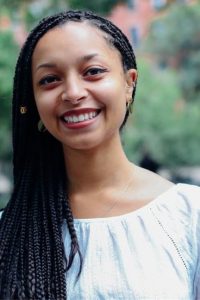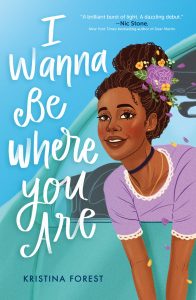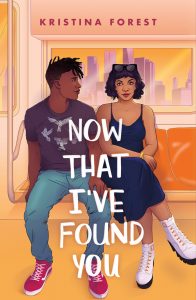
YA fiction featuring Black characters is having a moment, especially on the Science Fiction and Fantasy side. But not only those genres. Realistic contemporary is right alongside them offering reflections of Black teenagers that even a few years ago, we weren’t seeing regularly. Now, I’ll admit, since I’m raising a little bunhead of my own, today’s honoree got all the extra points from me. Kristina Forest’s books are full of Black teens pursuing the Arts, which means, watch out world. Because when readers can see it, they can be it.
The Journey
I’ve always been a big reader. I guess that’s where the journey begins for most writers. I loved English class and picture prompts were always my favorite assignments. In middle school I was obsessed with The Baby-Sitters Club and the work of Virginia Hamilton, and when I became a teenager, I fell in love with YA romance, specifically. It had never really crossed my mind to write anything else other than YA. I love to write about people who are experiencing things for the first time. There’s something so fresh and special about that. I majored in writing in college, so I started to take that path pretty seriously after high school. I wanted to be a professional writer, and I wanted to write inclusively. I didn’t see myself or my friends in many of the stories that I read, so that was a huge driving factor in my desire to be published. I Wanna Be Where You Are and Now That I’ve Found You are the kinds of books that I wished I’d had as a teenager.
The Backstory

I always know that a story idea is special if I dream about it, or if a scene or image comes to me in a daydream. That sounds strange but bear with me. I dreamt the plot of I Wanna Be Where You Are, and that very same morning, I woke up and wrote down everything that I remembered. Now That I’ve Found You was a little different. At the time, I’d been working on another idea, which I can’t even remember now, and while taking a writing break to clean my apartment, I suddenly pictured a boy and girl standing in front of a huge mansion. I knew that neither of them lived there, but the girl had a relation to the owner of the mansion. From the way the boy and girl looked at each other, I knew they shared a secret. I kind of thought, Hmm. What’s their story? I went to work on figuring that out. Months later I handed in the first draft for what would be my second book.
For both of these stories, I didn’t know the overall themes from the outset. The themes crystallized while drafting. IWBWYA is about confidence and taking risks. NTIFY is about self-worth and learning to trust yourself and others. Romance is, of course, also a big theme in each book, and I guess that is where I usually start. Who is the protagonist? What are their likes and dislikes? What are their goals? Then I decide who would be the ideal match for them. I love to write romantic tension—it makes the happily ever after that much more rewarding—so there is always some push and pull between the two characters.

It’s important for my characters to have interests and hobbies and goals. I believe that it helps them to feel fully formed. These interests and goals are often tied together. Chloe’s interest is ballet; her goal is to become a professional ballerina. Eli’s interest is art; he wants to go to art school. Evie’s interest is acting; she wants to be a big movie star just like her grandmother. Milo’s interest is music; he wants his band to get signed to a record label. I wish I had a clever answer for why all of these interests happen to be in the creative arts, but the truth is that they’re just my own personal interests that I’ve given to my characters. I was a ballerina in high school, just like Chloe. I’m not very good at art, but I enjoy it and my brother is an artist. I can’t act, and I’ve never tried, but I’ve always been fascinated by old Hollywood. And I love music, although I can’t sing or play an instrument to save my life.
The Writing Process
I work full time, so I have to stick to a very strict writing schedule or else the book just won’t get written. Sometimes if I’m behind on a deadline, I will write every day for a couple hours after work until I meet my goal. If I’m on track to hit my deadline—or if I’m not on a deadline at all—I try to stick to something more sustainable: two weekdays after work and Sunday afternoon, and occasionally on Saturday morning. That’s pretty ideal for me. I learned early on that writing without a general sense of direction does not work for my process, so I outline pretty heavily. Things change throughout the course of drafting and editing, of course, but usually the beginning, climax and ending remain the same.
The Buzz
Now That I’ve Found You (June 2020) is now available for pre-order
Check out the review of I Wanna Be Where You Are in The New York Times
